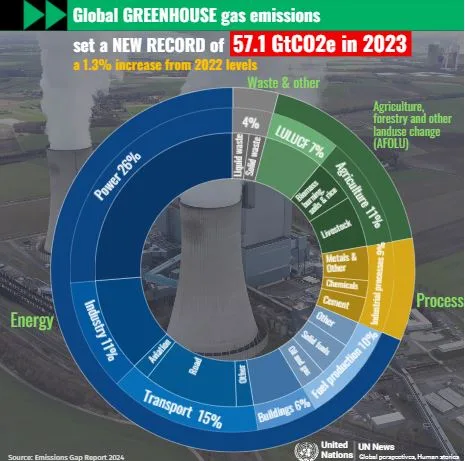Syllabus: GS3/Environmental Impact Assessment
Context
- The Emissions Gap Report, an annual publication of the UN Environment Programme, has been released.
About
- It is UNEP’s spotlight report launched annually in advance of the annual Climate negotiations.
- It tracks the gap between where global emissions are heading with current country commitments and where they ought to be to limit warming to 1.5°C.
- Each edition explores ways to bridge the emissions gap.
- The report assessed countries’ Nationally Determined Contributions (NDCs), which they are required to update every five years, to determine how much the world might warm if these plans were fully implemented.
| About The United Nations Environment Program (UNEP) – It is the leading environmental authority in the United Nations system established in 1972. – The UN Environment Assembly is the policy-making organ of UNEP. – Headquarter: Nairobi, Kenya. – Major Reports: Global Environment Outlook, The Rise of Environmental Crime Report, Actions on Air Quality, Frontiers Report, Adaptation Gap Report. |
Major Findings
- 1.5 Degree Target: It warned that the Paris Agreement objective of keeping global rise in temperatures to within 1.5 degree Celsius would be gone within a few years.
- The bare minimum required to keep the 1.5 degree target in sight was 42 percent reduction. The reductions must increase to 57 percent by 2035 to keep the target alive.
- Global emissions in 2023 was 1.3 percent higher than the previous year.
- Greenhouse gas emissions of China and India, two of the top three emitters, grew by 5.2 percent and 6.1 percent respectively.
- Future Predictions: Current climate actions, even in the most optimistic scenario, could reduce global greenhouse gas emissions by only 10 percent by 2030 on 2019 levels.
- The 2 degree Celsius threshold would be in danger of being breached, unless countries dramatically scale up their climate actions to reduce global emissions in two years.
- Without dramatic cuts to greenhouse gas emissions, the world could face an inevitable 3.1°C temperature rise.

- Recommendations:
- There is a need for a massive increase in investment in emissions reductions.
- Boosting solar photovoltaic and wind energy usage could contribute 27 percent of the total reduction in 2030 and 38 percent by 2035.
- Additionally, forest conservation could provide around 20 percent of the necessary reductions in both years.
- Other effective strategies include enhancing energy efficiency, electrifying various sectors and transitioning from fossil fuels in buildings, transport and industry.
India’s Nationally Determined Contribution (NDCs) Goals
- India seeks to achieve following targets by 2030:
- Emission Reduction: India aims to reduce the emissions intensity of its GDP by 45% by 2030, compared to 2005 levels.
- Renewable Energy: The country seeks to achieve 50% of its energy needs from non-fossil fuel sources by 2030, with a target of installing 500 GW of renewable energy capacity.
- Carbon Sink: India plans to create an additional carbon sink of 2.5 to 3 billion tonnes of CO2 equivalent through afforestation and reforestation efforts.
Source: IE
Previous article
Benefit Sharing for the Use of Digital Sequence Information (DSI)
Next article
Private Sector Participation in Space